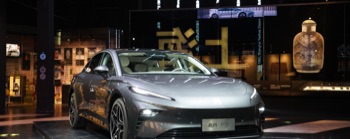I come from an architectural design background. Starting from learning the design system, I may evaluate the pros and cons of a design work from aspects of aesthetics, functionality, etc. However, no matter how complicated the previous and middle phases of the argument process are, the standard to judge whether a design work is excellent or not must be whether it is easy-to-use.
The same is true for the design of car cabins. Nowadays, domestic car companies have no shortage of excellent design concepts, such as the living room concept created by NIO ET7 featuring simple style but exquisite materials; or the integrated three-screen surround cockpit of Leapmotor F7, which has a strong integrity and clear functional divisions. Interestingly, I had the opportunity to face these two cars at the same time. As a visitor, I attended the “Bach Cockpit” themed event held by Leapmotor F7 in Shanghai Glass Museum. After experiencing these two new energy electric cars with the same positioning in detail, I got a lot of ideas…
NIO ET7
Leapmotor F7
Although the cabin designs of these two cars are excellent, and the styles of the two cars are presumably acceptable to most people, they each have their own characteristics in some details. However, the ultimate essence of a cabin is “seating”. If even the “comfortable seating” cannot be satisfied, talking about refrigerators and color TVs is a pipe dream. Leapmotor F7 obviously understands this point.
The engineers of Leapmotor F7 optimized the curvature of the backrest of the F7 seat based on the physical indicators of thousands of Chinese people and the testing of body pressure distribution, trying to fit people’s backs as much as possible at the position of the lumbar vertebrae. On this basis, they also thickened the soft foam layers of the seat cushion and the backrest, and prolonged the seat cushion. All these are to serve an indicator, that is, how to make the seat more fit the human body, how to make the seat better support the human body. This feeling is really obvious after experiencing NIO ET7 and Leapmotor F7 on the spot. Therefore, even if I describe these parameters in more detail, it is not as good as everyone personally experiencing it. Don’t worry, the exhibition cars of F7 will soon be available in various exhibition halls, and this efficiency is still acceptable.
Of course, as a car manufacturer, Faway understands the core design of each component and area, such as designing the appearance and body shape for the body, studying the arrangement of double wishbone and five-link suspension for the chassis, making passengers comfortable when designing the interior, and then considering the car’s machine interaction and multimedia entertainment. These are all additional gains.
In terms of aesthetic design, there is no problem with the cabin of the NIO ET7. However, the seat design could have been better, especially the sagging in the center of the driver’s seat and the angle of the backrest of the rear seat. Nevertheless, the ET7 still has some functional advantages, such as the hidden front air outlet that avoids blowing air directly at passengers and a soothing mode that slightly improves the sitting experience. On the other hand, the Faway F7 uses the traditional manual steering mode for the air outlet design, which I think is better than adjusting it in the screen like in the ET7. Therefore, both cars have their own strengths and weaknesses in terms of functionality, but Faway F7 is the winner when it comes to “sitting experience”. These are my opinions, and I welcome any comments or additions.
This article is a translation by ChatGPT of a Chinese report from 42HOW. If you have any questions about it, please email bd@42how.com.
